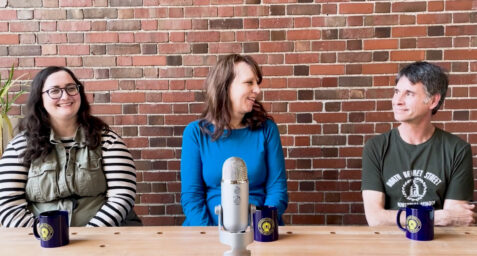In the Making: Matt Narkevicius
“Will it be called “Stradachairius” if it’s in the show?”
Matt Narkevicius is a graduating student of the Cabinet & Furniture Making program, and has leveraged his background and woodworking skills in an unusual way: by serving as an apprentice to a master of harp restoration at Swanson Harp Company in Boston.
When NBSS closed its building in mid-March, Matt’s apprenticeship proved essential to keeping both his hands and his mind busy. He’s so focused and diligent in his craft that his employer will often come down to the shop at 9:00 pm and tell him to “stop working!”
I virtually visited with Matt at the harp shop to discuss his current day-to-day. In talking about instruments— he was surrounded by harps on our call—we naturally turned to an unusual piece of furniture he recently completed, which he fondly named the “Stradachairius.” The video above, and the conversation that follows explains this moniker well.
Below is an excerpt from our conversation, edited for space and clarity.
Kristen Odle: The big ask in these interviews I’m having is, “what are you doing to keep your hands busy, being away from your bench?” But that doesn’t seem like that’s a problem for you, does it? I mean, you’re swimming in harps there.
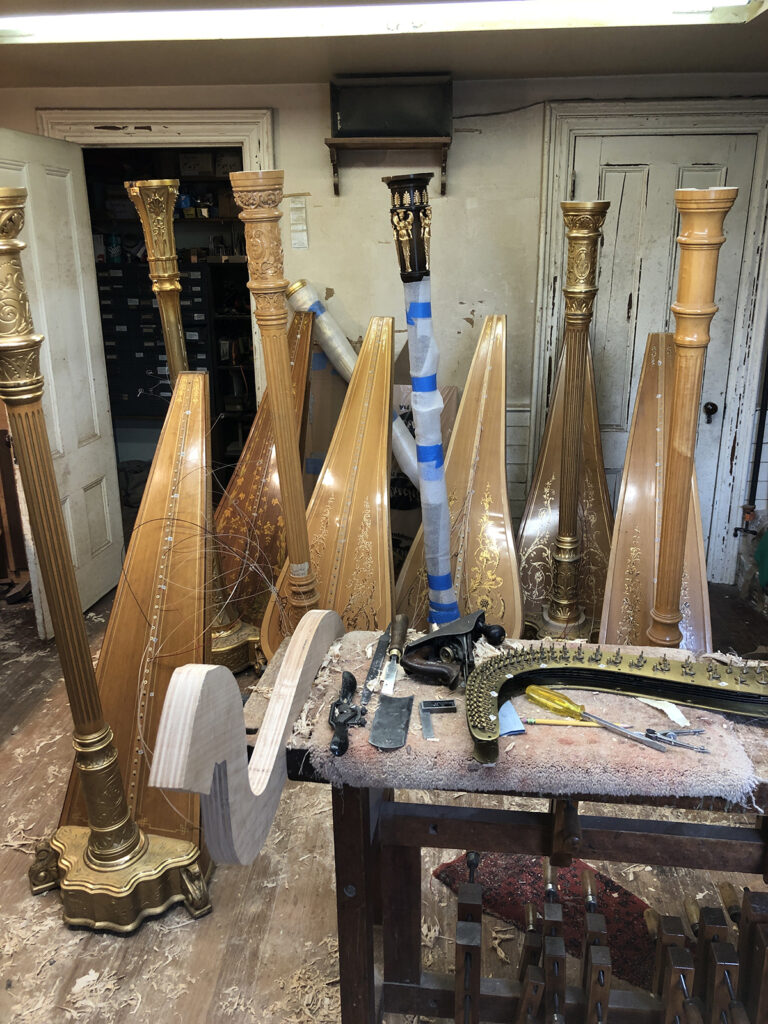
Matt Narkevicius: Ha, no not at all. I have a lot of work here in the harp shop.
It’s been hard juggling school and the apprenticeship at the same time. So [having a break from hands-on instruction] is kind of nice. It gives me a couple weeks to focus on this and get a lot done.
KO: What an inspiring place that you’re in.
MN: I’m enjoying it. It was a happy accident getting here. There is just so much going on in the shop… I definitely miss school and look forward to being back though.
KO: What are you missing about it?
MN: Being able to just create a project from scratch. Look at old stuff and then get creative with the design and actually build something. Working on harps is satisfying in itself though, because it’s an instrument, so there’s another element to it. A lot of these are people’s instruments, and they get used a lot. When it’s broken and you fix it… it’s satisfying when you return it to the customer.
KO: Because instrument repair runs over a span of time, this business might not be so affected by closures right now.
MN:. It’s keeping me very busy. And the shop is in my boss’s house, so he’s actually been letting me live here. He’s older, so it’s better if I’m just staying here in the shop.
KO: That’s great. What hours are you getting up and working, and then when are you done?
MN: I get started around 9:00, and then probably end around 9:00 at night—when my boss yells at me to stop working. [laughs]
KO: Oh my gosh. Tell me something new that you’ve learned working these long stretches of day. Is there something new that you’ve learned about harps or about woodworking?
MN: I’ve definitely found that it’s a challenge to keep yourself busy for that amount of time. So I’m not always working on one thing. For example, we have six necks going, and I’m trying to keep all of them relatively at the same spot so that when it comes to a gluing operation I have to wait for a couple hours I have something else to pick up and just keep myself going.
It was kind of challenging figuring out how to keep the work flowing in the shop. My problem-solving skills have improved a lot because there can be any number of problems, and the harp’s not an easy thing to wrap your head around.
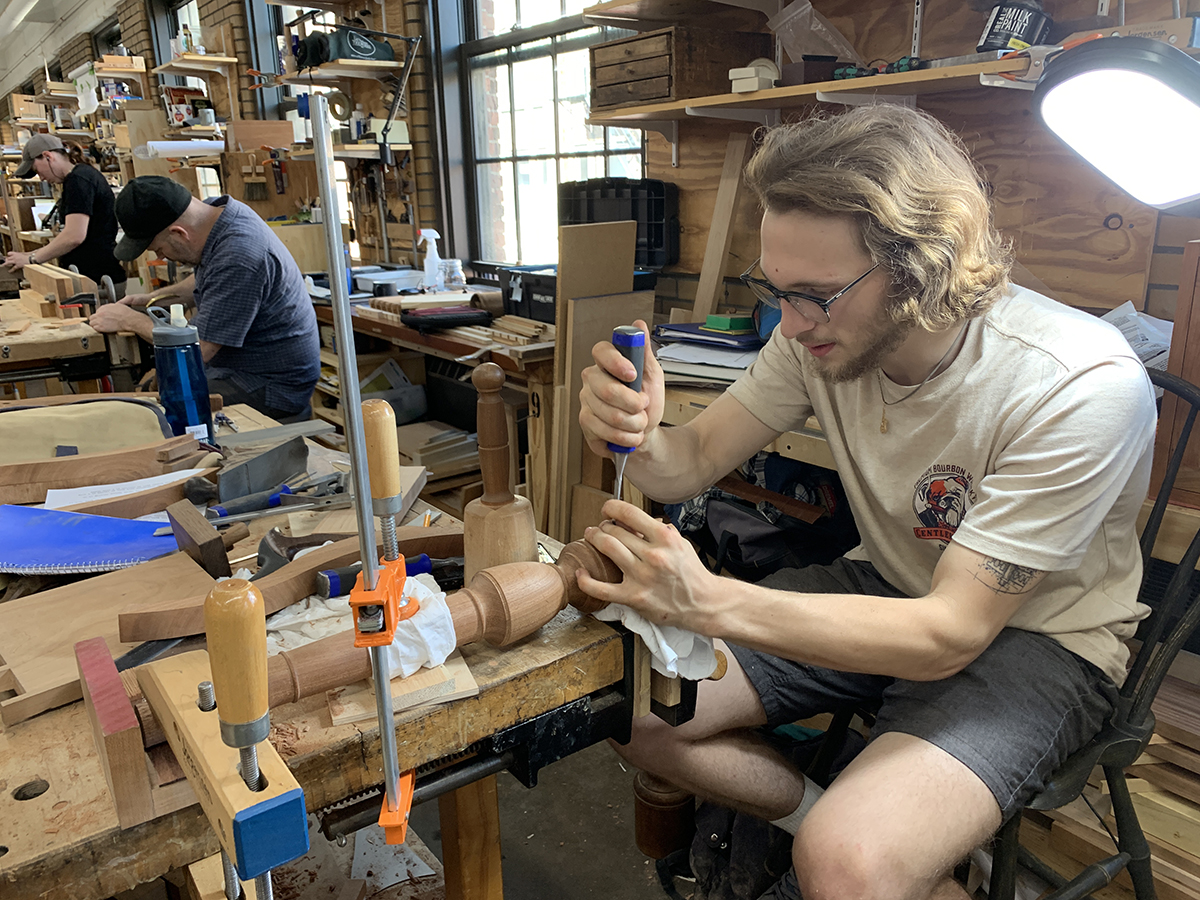
KO: And you don’t have an instructor sitting there. You can’t run over somewhere and ask how to solve that problem.
MN: Yeah. My boss is pretty good, he’s like the equivalent of one of the [Cabinet & Furniture Making program] instructors… He’s like the Lance [Patterson, NBSS faculty member] of harps. He used to own a factory manufacturing harps.
But it’s still difficult only having one person to talk to, as opposed to the four in my program. You still have to figure out the problem on your own to a certain extent.
I really enjoy the problem-solving aspects though. If I ever come to a point, like if I’m not sure that the neck is sitting on the instrument the right way, and the strings are lining up, I’ll come up with my best guess on how to solve the problem, how to get it where it needs to be.
KO: A question about harps, and strings, and instruments: Do you ever wander into the Piano Technology program out of your stringed instrument curiosity?
MN: I’ve definitely found myself looking at the pianos and just looking in the windows to see the mechanics, but it looks a lot more complicated than a harp.
KO: Does it? I wonder if they would say the same thing.
MN: Yeah. I mean, essentially the harp structurally is a triangle and once you wrap your head around it, I feel like it’s not too crazy, but I feel like the piano just is a lot. There’s so much more going on. There’s a lot more mechanics. It’s just a different instrument.
KO: Got it. So before I ask you about your chair, are you intending to learn how to play the harp?
MN: I’m trying. Not as much as I’m working on fixing them, but it’s a work in progress.
I’m struggling with “Twinkle, Twinkle Little Star.”
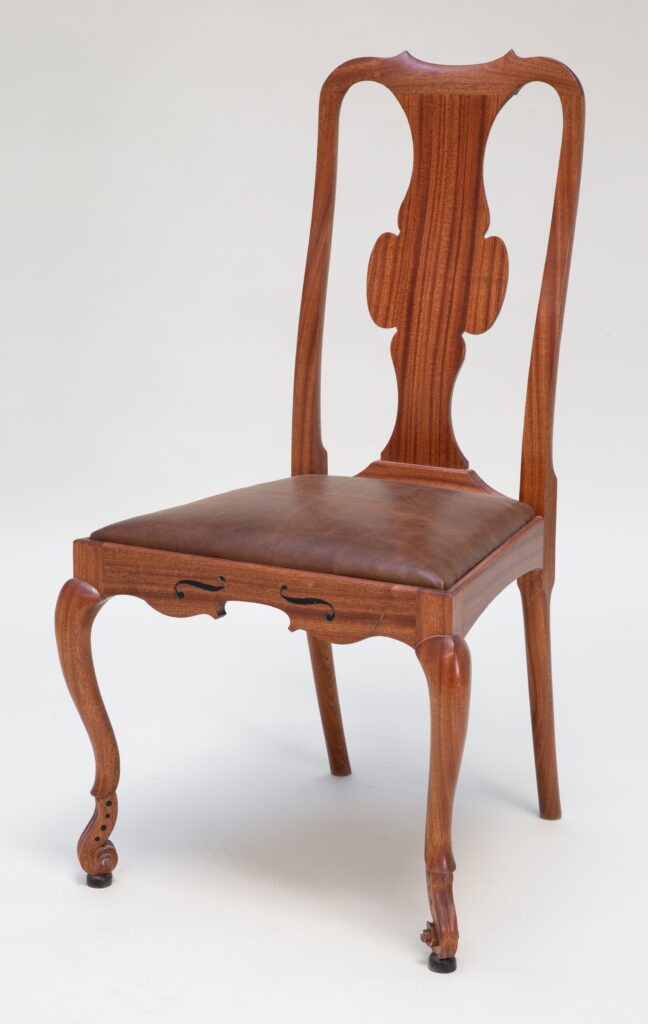
KO: Ha, nice. Ok, so I have your chair pulled up. Tell me again what you named it?
MN: The Stradichairius.
KO: Yes, that’s it! Why that name?
MN: Originally, I was looking through past student work, and I came across a pair of Chippendale chairs, and the back splat was in the profile of a violin. I liked the idea, but to me, it just looked awkward having the violin as the back splat. So I took that idea and I mixed it with how in traditional Queen Anne chairs, oftentimes there’ll be some type of bird in the negative space of the chair, so that’s how I came up with making the violins in the negative space.
KO: Makes a lot of sense. It’s the inverse, and it fits with it being a Queen Anne chair.
MN: Yeah. It flowed into the shape of the crest rail and the shoe really nicely too.
Next was making cabriole legs with the violin scroll as the foot. That was hard to design and actually make – when I was drawing it, it just looked kind of like a clown shoe to me. So I asked Lance for help and he was like, “Why don’t we just spin it around?”
I could tell he got into the idea because he was like, “Well, we can put tuning pins in the feet too, but someone might break them off.” I just went with putting in little ebony dowels.
KO: Are the scroll feet to scale?
MN: Yeah, yeah.
KO: That’s so cool, Matt. You should be really proud.
MN: Thank you. I’m pretty happy with it. It’s really comfy too.
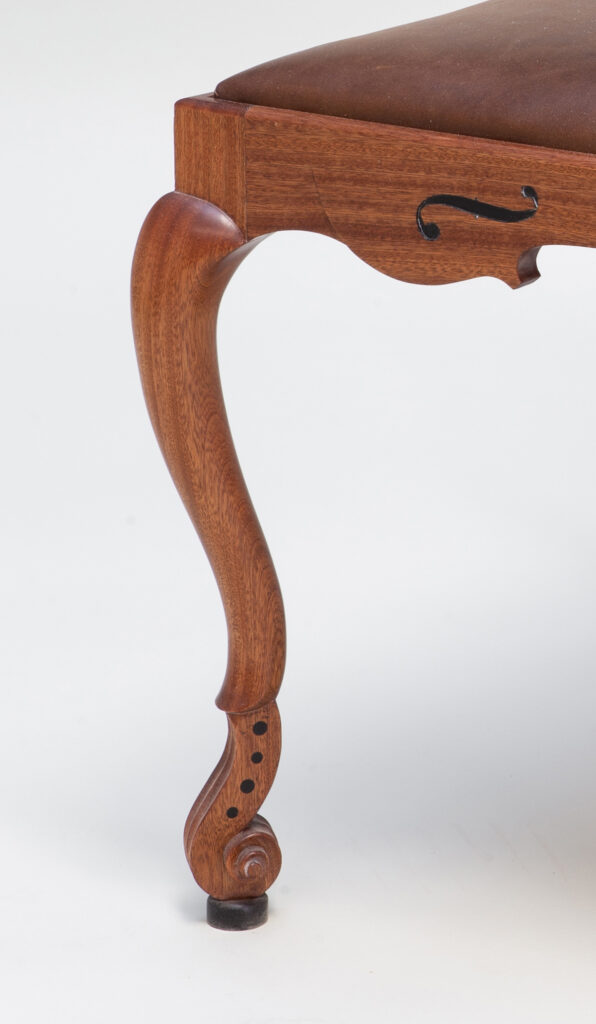
KO: We need to have a musician playing on it. Growing up I would only practice my cello on this one chair that my grandfather made me, like a talisman, a lucky charm. “Stradichairius” deserves to be that for some musician.
MN: Thank you. If it goes into the [Annual Celebration of Craft] show, will it be named Stradichairius?
KO: Absolutely. Yeah. I’m not going to mess with that. No way.
MN: Ok, thank you. [laughs]
KO: Any other furniture pieces you’re working on? Is this all harp, harps, harps every day?
MN: Yeah, because of the workload it’s pretty much harps every day right now. Plus, I had only just started work on my case piece [when the building closed]; pretty much just the drawing and then rough milling the wood so far.
KO:What kind of case piece is it?
MN: It’s a small liquor cabinet with two adjustable shelves and a coopered door on the front with a lot of veneering inlay. It’s not too crazy construction-wise, but on the front door, I’m getting creative with the design and and playing with inlay, shading and stringing techniques. I do a lot of carving. I like carving, and I’m trying to learn new skills too.
KO: I can’t wait to see what you create next. Thank you for chatting, Matt.
MN: Thank you, Kristen.
“In the Making” is a series of video interviews with members of our community where we get insight to their lives and work. Learn more about the conversations, and view a full list of interviews on the series homepage.

